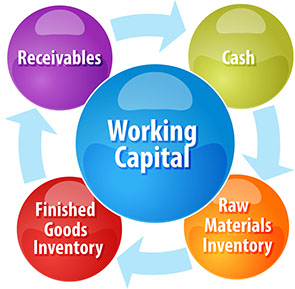Cash Flow Improvement
Working Capital Improvement
Definition: Working capital is a measure of both a company's efficiency and its short-term financial health. Working capital is calculated as: Working Capital = Current Assets (minus) Current Liabilities. The working capital ratio (Current Assets/Current Liabilities) indicates whether a company has enough short term assets to cover its short term debt. Anything below one (1) indicates negative W/C (working capital). (Investopedia.com)
Errors: Working capital is usually very easy to calculate and can normally be done in a few seconds. This calculation becomes difficult, if not impossible, if a company's Balance Sheet and Income Statements are not correct and or if these financial statements are not issued to the owners on a timely basis (within a few days after month-end). Erroneous and late financial information may cause significant pain to a business owner.
Internal: Working capital for internal purposes is critical. It tells the owner of a company whether there are enough assets to cover short-term liabilities, such as payroll, rent, debt service, accounts payable to vendors, income taxes owed by the owners and/or the company, other overhead, etc. Importantly, working capital will tell an owner if the company will have enough assets for other things, such as owner distributions, capital expenditures, investments in marketing and sales, etc.
External: Any bank or lender will know the working capital ratio for your company's industry (See our Industry Comparative Reports on The Discovery Analysis™ on this website). One of the first things a bank will do is to measure a company's working capital ratio to the average industry ratio. A working capital ratio that is below industry standards might cause banks to either deny loans or to increase interest rates, costs, etc.

Improvement: There are many things a company can do improve working capital. These improvements may take time and much work. Below are some generic improvement suggestions that might help with these efforts.
- First, cause your company to have timely and accurate financial statements, meaning, there are no errors on the Balance Sheet and Income Statement and that these financial instruments are given to you within a few days after month-end.
- Create consolidating financial statements if your company owns subsidiary companies.
- Collect accounts receivable within the terms on the customer invoices.
- Keep very little excess inventory and have no obsolete inventory.
- Negotiate discount terms with key vendors.
- Have an expert help you move some short-term debt to long-term debt, if this move is necessary and prudent.
- Have your staff provide monthly and accurate Cash Flow Projections. These projections should be on a seven-month rolling basis, at a minimum.
- Improve bottom-line profits by increasing sales, sales margins and/or by decreasing expenditures.
- Obtain and properly manage a working capital line of credit, if necessary.
- If possible, ask for advance deposits from customers, especially those that you think might be late on the payment of their invoices.
- Hire competent talent that not only understands this topic but that has decades of experience.
